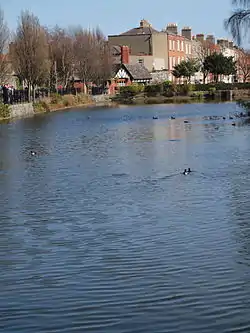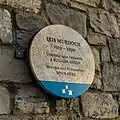Blessington Street Basin
Blessington Street Basin (Irish: Báisín Shráid Bhaile Coimín) is a drinking water reservoir in Dublin which operated from 1810 until the 1970s, serving the north city. It became a public park in 1994.[1]
| Blessington Street Basin | |
|---|---|
 | |
 Blessington Street Basin  Blessington Street Basin | |
| Location | County Dublin |
| Coordinates | 53°21′N 6°16′W |
| Type | reservoir |
| Native name | Báisín Shráid Bhaile Coimín (Irish) |
| Basin countries | Ireland |
| Max. length | 120 m (390 ft) |
| Max. width | 60 m (200 ft) |
| Water volume | 15.1 megalitres (12.2 acre⋅ft) |
History
The Blessington Street Basin was built in the early 19th century by Dublin Corporation. Construction began about 1803 and finished in 1810, the plant was opened as the Royal George Reservoir, named in honour of King George III.[2] The basin is rectangular, about 120 m long and 60 m wide basin took about 4 million gallons (15.1 million litres) of water.[3] The water came from Lough Owel in County Westmeath,[2] carried by pipe along the Royal Canal through a 3 km long pipeline into the basin at the western end of the Blessington Street. From its construction, the site was used as a public park.[4]
By 1869, the basin was not large enough for purpose, and water collection moved outside the city.[2] The basin continued to serve the Jameson's and Powers' distilleries until the 1970s, and then went out of operation as a reservoir.[5] There were worries about the stagnant water creating a typhoid outbreak in the late 1800s leading to the corporation wanting to fill in the basin and the stretch of water connecting the basin to the canal, this connection was finally filled in 1956.[3]
Refurbishment
In 1993 work began on the restoration of the site following a rejected proposal to extensively refurbish it in 1991.[5] The refurbishment was carried out by the Dublin City Council aided by FÁS, and with financial support from the National Heritage Council and A.L.O.N.E..[6] It was reopened as a park on the 4 November 1994. The site also includes a lodge house built in a Tudor style in 1811,[4] and another modern council building.[5]
%252C_Dublin_-_house.jpg.webp) Lodge house, built in 1811
Lodge house, built in 1811 Plaque commemorating the opening of the park
Plaque commemorating the opening of the park%252C_Dublin.jpg.webp) West entrance
West entrance%252C_Dublin_2.jpg.webp) Plaque unveiled by David Norris in 2018, with a quote from James Joyce's Ulysses that mentions the Basin
Plaque unveiled by David Norris in 2018, with a quote from James Joyce's Ulysses that mentions the Basin The Iris Murdoch Commemorative Plaque erected in the Basin
The Iris Murdoch Commemorative Plaque erected in the Basin Blessington Street Basin from above
Blessington Street Basin from above
Nature
Since its restoration, the basin now serves as a bird habitat, with an artificial island and a number of fish.[2][7] Amongst the birds that can be seen there are swans, tufted ducks, chaffinches, mallards and pigeons
References
- O Conghaile, Pol (2013). Secret Dublin: An unusual guide. France: JonGlez. pp. 32–33. ISBN 978-2-36195-071-2.
- Dublin City Public Libraries & Archive. "Blessington Street Basin, Phibsborough". Dublin City Public Libraries & Archive. Archived from the original on 13 April 2015. Retrieved 6 April 2015.
- Nolan, Conor (2001). "Off the beaten track" (PDF). Inland Waterways News. 28 (3). Archived from the original (PDF) on 2011-06-12. Retrieved 6 April 2015.
- UCD Archaeology. "Blessington Street Basin" (PDF). UCD Archaeology. Retrieved 6 April 2015.
- Cassidy, Lisa. "Blessington Street Basin, Dublin 7". Built Dublin. Retrieved 6 April 2015.
- Dublin City Council. "Blessington Street Basin". Dublin City Council. Retrieved 6 April 2015.
- Archiseek. "1891 – Blessington Basin, Blessington Street, Dublin". Archiseek. Retrieved 6 April 2015.